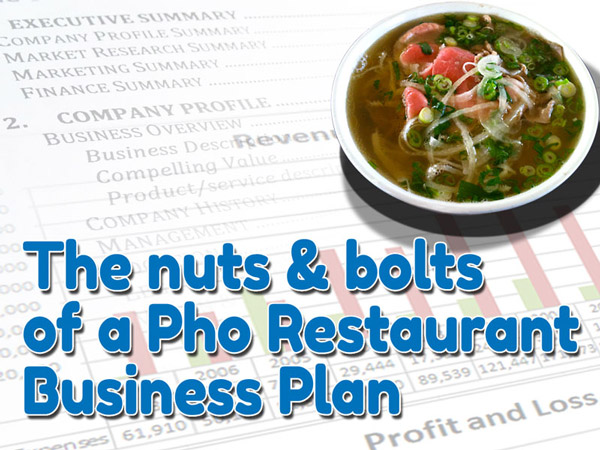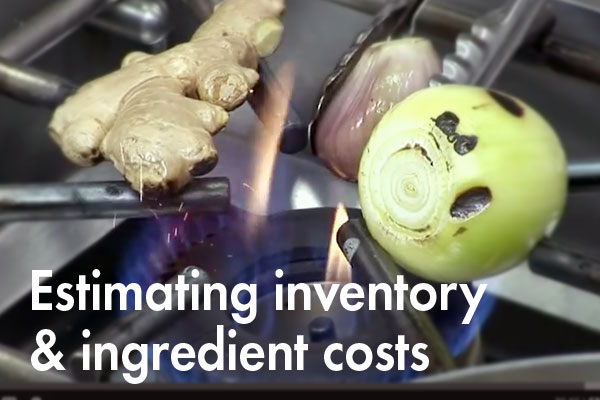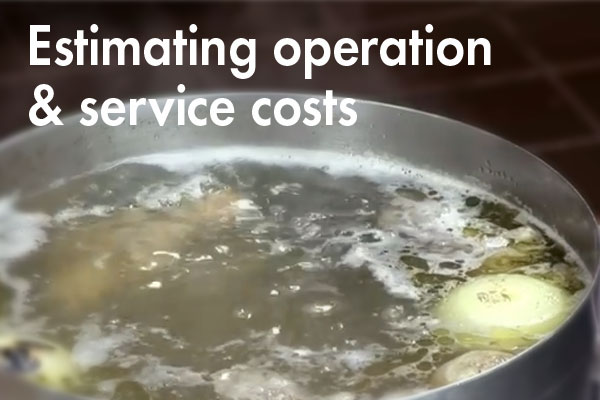This is part 3 of a series on pho restaurant business plan. Read Part 1, Part 2 and Part 4.
Rather not do the business plan yourself? Then take advantage of my service to create a pho restaurant business plan for you.
Updated 02-18-19. In Pho Restaurant Business Plan Part 1, we discussed why a business plan is important. In Pho Restaurant Business Plan Part 2, we discussed what important content should be included in the business plan. In this Part 3 of the series, we'll dig a little deeper to see how you can develop the content for a pho restaurant business plan and its pro forma.
The key thing to remember is, a pho restaurant business plan is a living document, and no one is expected to complete it overnight. It should be updated as you continue developing and building your new pho restaurant. Here's how you get it done.
Generating A Good Pho Restaurant Business Plan
I've run into many aspiring pho restaurateurs whose plan is: opening a pho restaurant, selling pho and making money. That's the extent of the plan. The rest is make it up as you go.
 Well, this is the recipe for failure. Maybe there are a few who succeed by riding on no particular plan whatsoever, but these are cases of freaky luck which you cannot count on all the time. There is a better way, and that way is have a good plan and follow it.
Well, this is the recipe for failure. Maybe there are a few who succeed by riding on no particular plan whatsoever, but these are cases of freaky luck which you cannot count on all the time. There is a better way, and that way is have a good plan and follow it.
Company Profile In Less Than 30 Minutes
Creating a restaurant means you're actually creating a company that employs people to serve the public. The process of creating a good restaurant starts with your understanding of what your company provides, how it will provide it, and for what cost.
As a start, just quickly write down what you think your pho restaurant aims to do. Don't worry about perfect grammar or readability at this point. The goal here is to jot down and have in writing whatever is in your mind, what you might have envisioned for the restaurant. You can always come back over time and improve on it later on.
Many people give the excuse that "I can't write well" or such nonsense. Of course anyone can write. But you're not writing a novel. You're just starting a draft. I guarantee you that once you pass the initial fear (that is really unfounded), it'll be much easier to come back to improve it later.
At this stage, I recommend bulleted list. It's very easy to do, it uses short phrases, and it's fast. Here's an example:
- My pho restaurant serves fresh and delicious pho to Viet and non-Viet customers.
- We prepare our food from scratch everyday.
- Our prices are very affordable.
- We treat our customers like neighbors and service them with care and respects.
There's your vision. And that took less than 5 minutes, right?
As you continue developing your menu and other aspects of your pho restaurant over the upcoming days and months or even years, your company/restaurant will continue to develop and you'll be able to come back and update your vision even more, maybe adding to it and expanding it. I guarantee you that your vision will also become clearer and clearer.
Now that you're got your vision down, let's take another few minutes to also say something about your mission, goals and objectives, such as
- "I want to serve the best Vietnamese pho food in the neighborhood" or
- "I want to operate this first store and maximize its profits as quickly as possible before opening a second store within 2 years" or
- "I want to serve the best pho within a 3 mile radius."
 I'm sure you have your own mission, one that you really believe in and are excited about. Regardless, write them down and keep going. You'll come back and update them later. And while you're on a roll, go ahead and say something about other parts of your plan, such as:
I'm sure you have your own mission, one that you really believe in and are excited about. Regardless, write them down and keep going. You'll come back and update them later. And while you're on a roll, go ahead and say something about other parts of your plan, such as:
- Your management team (owner/operator, general manager, front and back staffing and management, chefs, cooks, servers, etc.)
- Your choice for location (where you want to be, area of town, shopping mall, high traffic area, low rent area, etc.)
- Your company legal structure (sole proprietorship, partnership, limited liability company, corporation)
Done. You can pick it up again later to flesh things out even more. Let's move on to market research, sales and marketing, and operation.
Market Research, Sales and Marketing, and Operation
For each of these areas, just start the same way. Start with a few bullet points about what you think you want to do in each area. If you have more than a few bullet points for any area, then even better. It shows you have thought about it much more than you've given yourself credit for.
My experience is, people have a lot of good thoughts and ideas in their heads, but they're too lazy to write them down. With the method I'm describing, you can quickly get them off your mind and create a written record for them. In doing so, you have the start of a business plan, while freeing up your mind to figure out other aspects of your business.
Start with something you already know, or maybe with some quick online searches to verify a few numbers and facts. Your market research may start with something like this:
- There are 5000 homes (and families and schools) within a 5 miles radius of your potential location.
- There's a large hospital, factory, big company, etc. within 2 miles of your location that employs a large workforce or attract large number of business visitors.
- There are well-known hotels or attractions in the area that serve as destinations for out-of-town vacationing visitors.
Your sales and marketing may start with these:
- My menu items will be competitively priced in the local market, with a regular pho bowl priced at $7 and large at $8.
- My marketing strategy will follow both traditional and online campaigns. Traditional marketing includes direct mailers sent to local addresses in the area, printed advertising and 4-wall marketing. Online marketing includes social media channels, local search engine optimization and other digital marketing methods.
- Customers will be impressed by my staff's dedicated and friendly service, because I put each of my staff through a rigorous training program.
 Your operation should at least discuss some of the following:
Your operation should at least discuss some of the following:
- My plan to keep food cost low and food quality high includes using strict inventory control methods, giving detailed onboarding training to new employees, and maintaining multiple suppliers for key items.
- My staff will be trained to follow important food safety guidelines at all times, and will be given regular refresher, mini trainings to keep food safety on top of mind.
- My menu will be designed for easy selection and quick ordering by the customers, and be dynamic so that I can make adjustments any time with very little effort.
You get the idea, right?
As you continue, you can do additional research or data gathering to better define your market and positioning. You may also deploy a few unconventional techniques to really understand your market, competitors, and customer. I've employed many of these techniques, including parking myself outside of a competing restaurant to count people walking in their doors during lunch and dinner times. You'll be surprised what you can learn. If you really want to do this, there's always a way.
Generating A Good Pro Forma For A Pho Restaurant
A good business plan is incomplete without the financials, or as bankers and investors call it, the pro forma. Finance is not strong area for many people, and diving directly into one is not recommended without knowing the basics.
Wait, I take that back. Let me restate: diving directly into one is especially recommended for those without basic knowledge, so they can get their feet wet and learn the stuff.
So let's go over some basics of the pro forma.
A pro forma can be just a spreadsheet consisting of a set of input parameters and assumptions that will give you meaningful output based on those assumptions and calculations. In other words, the pro forma is used to show the projected performance (sales, costs, profits, breakeven points, etc.) of your new pho restaurant. It is your total restaurant in operation, all on a spreadsheet. It can tell you, if you do a certain thing, then you will get a certain result.
Once you have the pro forma set up, it can also serve as a tool for you to do "what if" or tactical scenarios. This is when you can explore different ways that things can go wrong or right with the business. An example may be, what if my sales on Mondays are much lower than originally anticipated, or what if the minimum wage increases this year, or what if I increase price of a bowl of pho by $0.20, then what would my projected sales and financial statements look like. Pretty neat and powerful.
Below are descriptions of key input and output parameters.
Input Parameters
- Assumptions. These are numbers reflecting specifically what your pho restaurant will be required to operate. The assumed parameters range from food costs and management salaries, to employee benefits and direct operating costs, to marketing and utilities expenses, to variable costs such as occupancy (lease), credit card charges and payroll processing. They are called assumptions because they are what you think you will spend when your new pho restaurant is in operation. Since you are yet to open, they are not actuals, they are assumptions.
- Capital Budget. These are costs that represent your project cost leading up to grand opening. The capital budget is essentially your budget to build the project. It includes improvement to the location (whether leased or purchased); kitchen equipment; design, consulting and other professional services; pre-opening expenses; and contingency capital. This is your investment to open the pho restaurant.
- Sales Projection. The sales projection represents your sales for each day of the week based on the number of covers per day and the sales amount per cover. Of course since you haven't opened yet, the numbers in this section are guesses. But with a little extra effort, one can get a fairly accurate weekly sales projection for your new business.
- Hourly Labor. A pho restaurant will employ a number of hourly staff members. Their labor costs are estimated in this section. In order to accurately arrive at labor costs, the section can consider individual positions within the restaurant, each with its own pay rate. Then together with assumed numbers of hours per position required to cook and serve the restaurant's menu to projected customer counts, hourly labor costs can be calculated.
 Output and Results
Output and Results
- P&L Projection. From the input parameters just discussed, detailed profits and loss (P&L) statements can be calculated for the first year and subsequent years (normally 3 or 5 year projection.)
- Breakeven Points. Also based on the same assumptions and projections, breakeven points can also be calculated for the initial investment, meaning, how fast an investment is expected to be recouped. Furthermore, daily/monthly breakeven sales can also be calculated to serve as daily/monthly targets to be met by the business to ensure profitability.
As you can see, both the business plan and pro forma serve a very important role in your venture, even before you open for pho restaurant business.
Final Thoughts
The business plan, once set up, is the roadmap for your business. If you don't have one, then you don't have a roadmap for your business. Once created, you will want to refer to it often in order to stay on track, and update it to adapt to changing market conditions.
The pro forma, on the other hand, is a tool that you probably want to use everyday, especially before opening. Once set up, you can keep updating it with more realistic pre-opening costs, and you can use it to vary all kinds of parameters (such as manager salaries or utility costs) to investigate different market scenarios. This will help you make important strategic decisions based on those results.
So there you have it, the foundation to opening your own pho restaurant. It can be a lot of work but then no one says opening a restaurant is ever easy. Remember, if you haven’t been in the foodservice business, what you see when going out to a restaurant is only about 10% of what’s really going on behind the scene. There are much more going on that you don’t see.
If someone tells you he didn’t do any of these things and still become successful with his pho restaurant, then he either is extremely lucky or is not telling the whole truth. Many people often depend on luck and that’s fine for them. For most everyone else, I would highly recommend doing your business plan and pro forma in order to increase or even to create your own good luck.
For professional assistance with a business plan and pro forma, head over to the page Pho Restaurant Business Plan and book a FREE half-hour consultation to get started.
Please leave your feedback in the comments below and let me know what you think.



